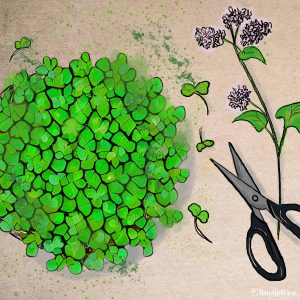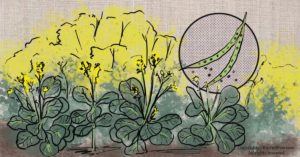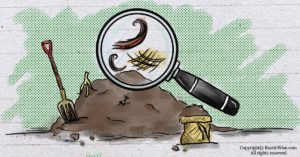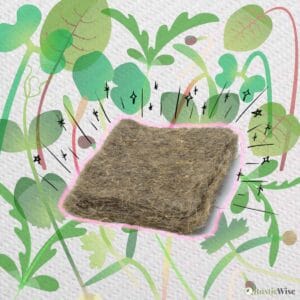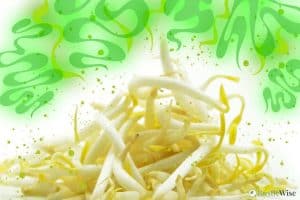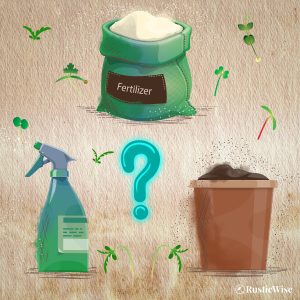Pea Sprouts vs Pea Shoots: What’s the Difference?
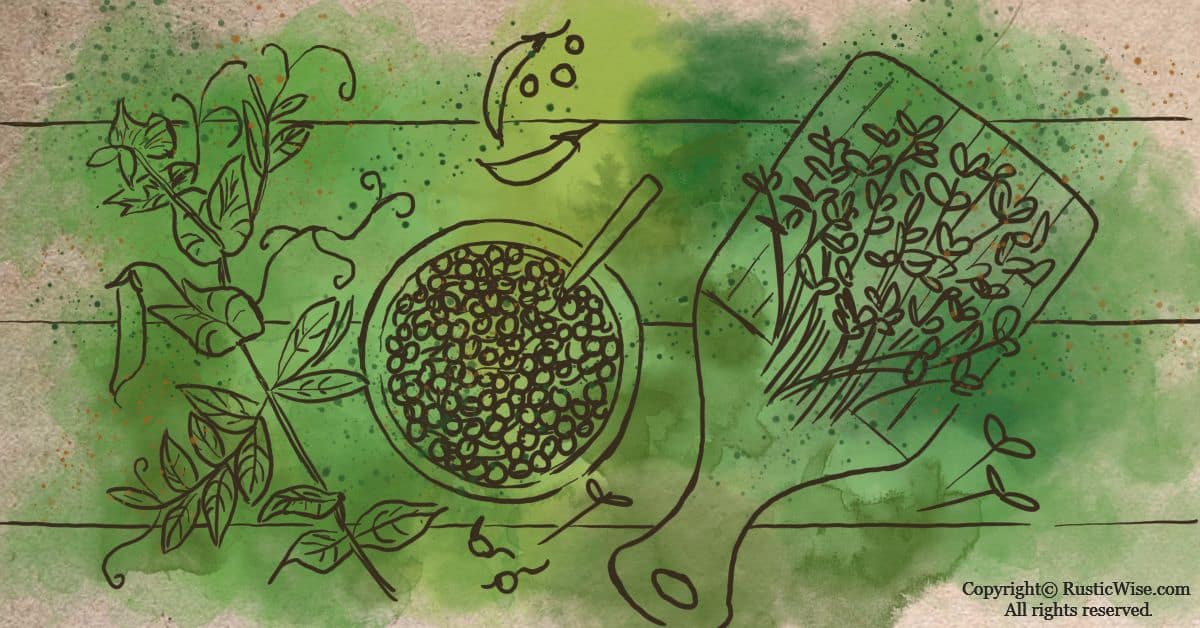
If there was a food that embodies the taste of spring, pea shoots fit the bill. Fresh, green, and slightly sweet, pea shoots are eaten cooked or raw.
If you’re wondering what the difference is between pea sprouts vs pea shoots, you’ve come to the right place. Pea sprouts are sprouted pea seeds which you eat whole (seed, root, and shoot). They are grown without soil, often in sprouting jars. Pea shoots are the tender young green shoots of pea plants that are typically grown in soil, and are harvested just above the soil line.
And if you’re wondering about pea microgreens, these are similar to pea shoots. We’ll go into more detail below about these commonly confused terms. We’ll also show you how to grow your own pea shoots at home.
The most common pea is the garden pea, also known as snow pea, or field pea (Pisum sativum). Peas can be green or yellow.
If you’ve ever bitten into a fresh garden pea, you’ll know the pleasantly mild and slightly sweet flavor. Please don’t confuse the garden pea with the sweet pea (Lathyrus odoratus). While the garden pea is edible, the seed pods of the sweet pea are toxic. Sweet peas are mostly cultivated for their fragrant flowers.
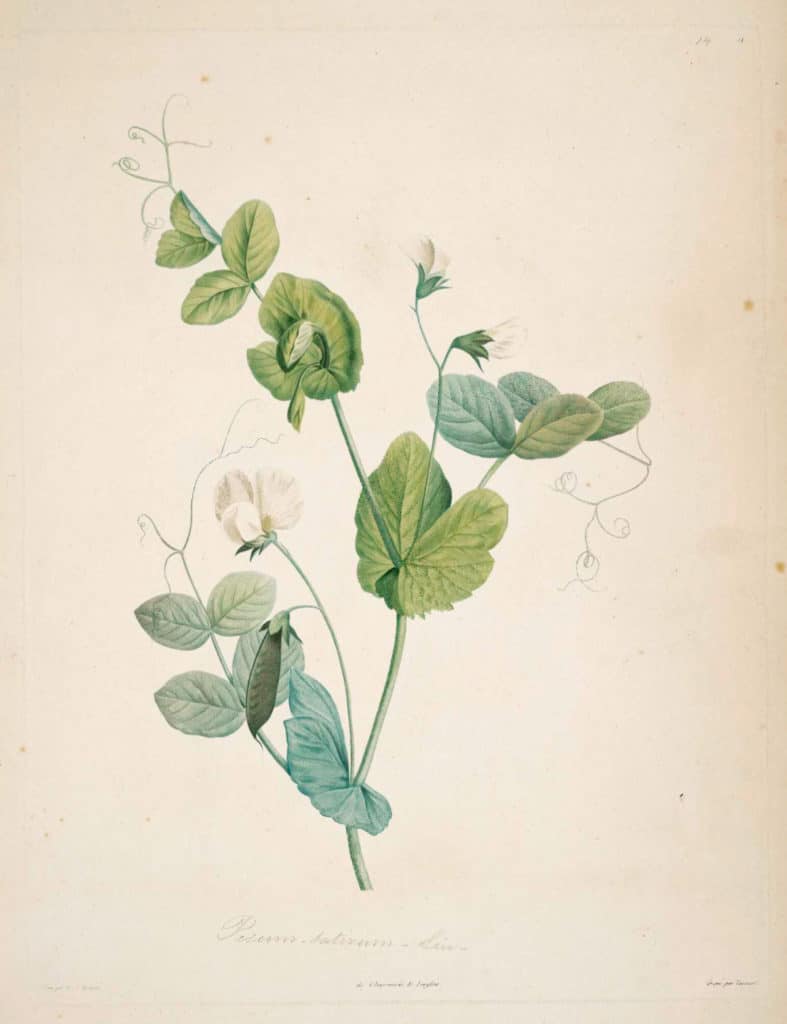
Credit: Swallowtail Garden Seeds / Flickr
Pea sprouts vs pea shoots (microgreens and pea tips too!)
When it comes to different stages of plant growth and the names of the corresponding greens, things can get a bit hairy! Many people use the terms sprouts, microgreens, and shoots interchangeably. There seems to be a lack of consensus about an agreed-upon definition of each.
Let’s try to straighten things out.
First, let’s start with pea sprouts. You can buy sprouting seeds to grow your own pea sprouts at home. Like other sprouting seeds, pea sprouts are commonly grown in a mason jar without any soil, or even much sunlight. You soak the seeds. You rinse them twice daily and drain. In 2–3 days, you’ll have germinated seeds (pea sprouts) ready to harvest and enjoy. Pea sprouts are ready to harvest when roughly 2 inches long. You eat them in their entirety (seed, root, and shoot).
In The Sprout Book: Tap into the Power of the Planet’s Most Nutritious Food, Doug Evans goes into more detail about the differences between sprouts, shoots, and microgreens.
“Sprouts” are a broad term that often applies to both shoots and microgreens. In a nutshell, shoots and microgreens technically are a form of sprouts. To be clear, when we refer to sprouts in this article, we’re referring to actual pea sprouts that grow from a germinated seed in a jar or sprouter.
Shoots (aptly named), shoot from a seed and are the earliest stage of germination. (To make things confusing, all sprouts actually have “shoots” that grow out of the seed.) Stick with me here.
Shoots are a type of seed sprout. Shoots and microgreens have many similarities in the way they’re grown. In fact, there’s really not much difference between pea shoots and pea microgreens.
Both pea shoots and pea microgreens are grown in soil (or another growing medium). You’ll mist them regularly and keep them in the dark until you see growth. At this point, you can place them in a room which gets natural sunlight (just keep away from direct sunlight). Let pea shoots grow longer than you would sprouts, between 3–4 inches before harvesting. Shoots and microgreens are harvested just above the soil line with a pair of scissors. Pea shoots are ready to harvest in 10–14 days.
The term microgreens refers to young plants that are harvested when only a few inches tall, before they’re fully mature. Microgreens contain the cotyledons (the very first seed leaves) of a plant which are packed with nutrients.
Microgreens have been around for ages, it’s just a fairly new term that’s applied to young plants. You can grow microgreens in potting soil, or some other type of growing medium (such as coconut coir), or even an unbleached paper towel.
If you want to get into the nitty-gritty differences between microgreens and shoots, it comes down to when the plant is actually harvested. Microgreens are typically harvested when only a couple inches tall and have the cotyledons in place. Some prefer to harvest microgreens earlier, just as the true leaves emerge. In the case of pea shoots, many people prefer to harvest them later, when they grow to 4 inches or more and have several true leaves.
With other types of shoots, you may actually prefer to harvest them sooner (before leaves appear). This is the case with growing corn shoots, a tasty and surprisingly sweet snack we have an article about.
But really, pea shoots and pea microgreens are pretty much the same thing. Whether you decide to harvest earlier, or later when the plant has developed a set of its true leaves, is a matter of preference.
Taste tip: For more tender shoots with a milder flavor, harvest younger pea shoots.
What are pea tips?
And just to keep things interesting (and not at all confusing!), there are also pea tips, sometimes called pea tendrils. Pea tips are the stems, vines, and leaves of a mature pea plant.
Pea tips (or tendrils) have long been a culinary staple in Asian cuisine. There’s a popular Chinese dish which my mom loves called dau miu (pronounced dow-mew). This dish uses the vines and top leaves of a mature pea plant. When lightly sauteed or stir fried with garlic, a splash of soy and oyster sauce, it makes a scrumptious side dish.
Here’s a handy chart to help explain the differences between pea sprouts vs pea shoots (or microgreens), plus pea tips.
Table: Pea sprouts vs pea shoots vs pea tips
| Pea Sprouts | Pea Shoots/Microgreens | Pea Tips | |
|---|---|---|---|
| Grown in soil | No | Yes | Yes |
| Approximate days to harvest | 2–3 days | 10–14 days | Once mature plant begins to sprout top leaves and vines. |
| Requires sunlight | No | Yes, after the initial blackout period. | Yes |
| Parts eaten | Seed, shoot, root | Harvested above the soil line (shoot and leaves). | Harvested vines and top leaves from a mature pea plant. |
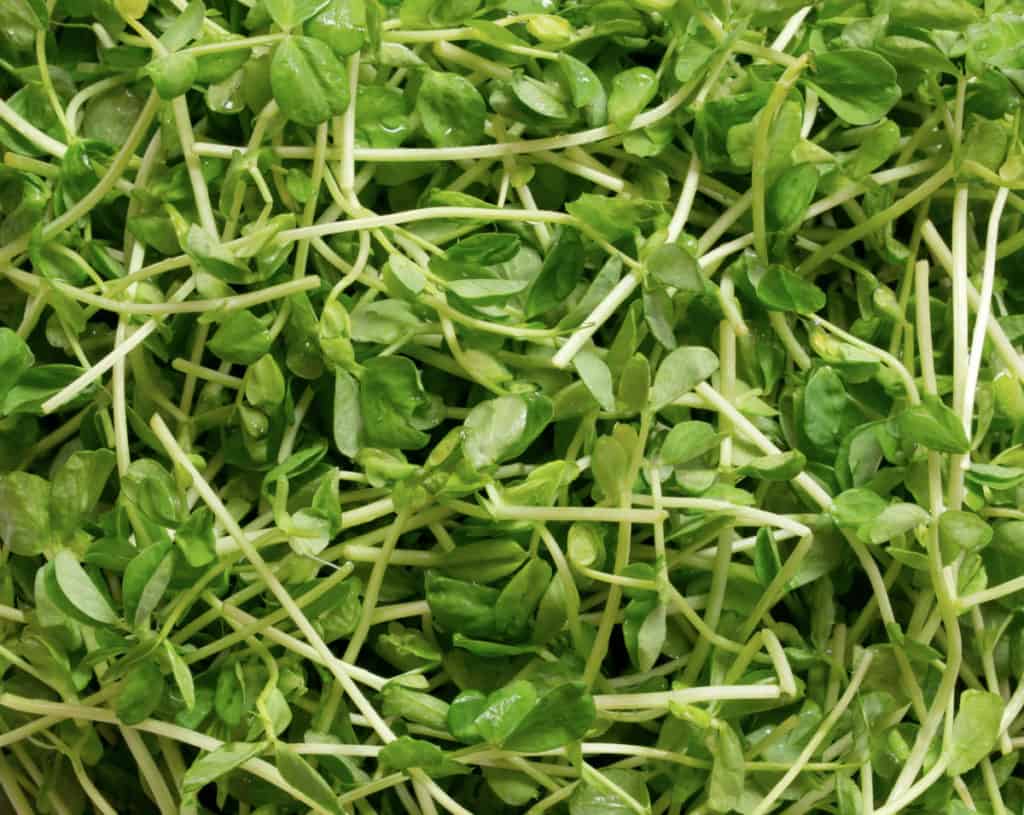
Credit: Yay Images
Health benefits of pea shoots and pea sprouts
Peas are a rich source of protein, iron, vitamin C, beta-carotene, folate, and fiber (soluble and insoluble).
Here’s a comparison of 100 grams of pea sprouts and pea shoots according to data from USDA Food Data Central. While this isn’t a perfect comparison as there’s some data unavailable, it still gives you a good idea of the nutritional profile of each.
Table: Nutritional information of pea sprouts vs pea shoots
| Per 100 grams | Pea Sprouts | Pea Shoots |
|---|---|---|
| Calories | 124 calories | 35 calories |
| Protein | 8.8 grams | 2.4 grams |
| Fat | 0.7 grams | 0 grams |
| Fiber | data unavailable | 2.4 grams |
| Carbs | 27 grams | 7.1 grams |
| Vitamin C | 12% of the Daily Value (DV) | 27% of the Daily Value (DV) |
| Folate (B9) | 43% of the DV | data unavailable |
| Iron | 13% of the DV | 7% of the DV |
| Calcium | 3% of the DV | 2% of the DV |
| Potassium | 381 mg (8 percent DV) | data unavailable |
| Phosphorus | 165 mg (13 percent DV) | data unavailable |
How to use pea shoots
Young pea shoots are green, crunchy, and great as a lettuce, or leafy green alternative. Try mixing pea shoots and sunflower shoots for a tasty salad base.
Pea shoots are popular, because they taste awesome—slightly sweet, with crispy crunch, and a mild flavor. (Think of pea pods, but slightly milder.)
Ways to use pea shoots:
- Blend into a healthy juice.
- Add to wraps and sandwiches.
- Use as a replacement for mature leafy greens (a blend of sunflower and pea shoots go together like peanut butter and jam).
- Saute, steam, or add to stir fry.
- Add to soup during the last few minutes of cook time.
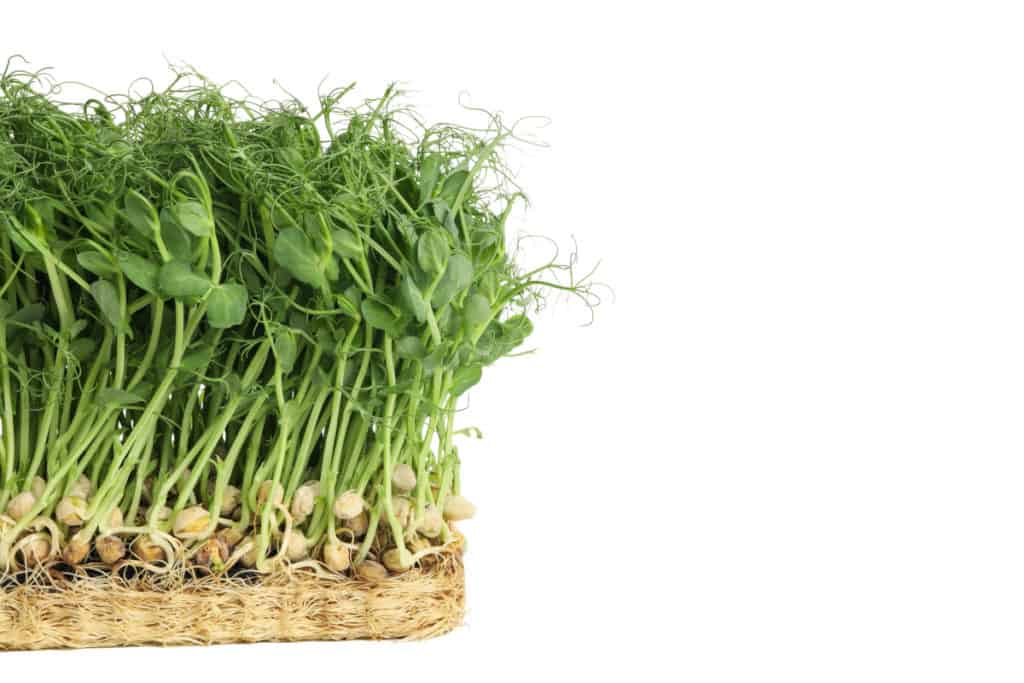
Credit: Yay Images
How to grow pea shoots
To grow pea sheets, start with a batch of good sprouting seeds (preferably organic). People often ask if you need to buy special sprouting seeds to grow sprouts or microgreens, and yes, we highly recommend it.
Normal seeds are treated or irradiated, meaning they won’t sprout. Treated seeds may have a coating of chemicals or pesticides. Good sprouting seeds from a reputable supplier are tested and free of harmful pathogens (E.coli and salmonella).
Look for seeds with the words “high-germination” or “sprouting seeds” on the label. Keep an eye out for a label saying the brand is USDA-certified organic. You can buy sprouting seeds from your local specialty food store, some gardening stores, or online through suppliers like Johnny’s Seeds, West Coast Seeds (Canada), or Sprout People.
Pea shoots or pea microgreens, require a few extra steps for successful growing (just like sunflower microgreens do). They need to undergo pre-soaking and pre-sprouting before sowing the seeds.
👉 Check out our article here for a more in-depth look at how to grow pea microgreens.
Tip: The trick to growing a successful batch of pea shoots or pea microgreens is in pre-sprouting the seeds. Most other types of microgreens don’t require this pre-sprouting step, but pea seeds benefit from this extra step. While it seems like a pain, it actually helps speed up the growing time.
How to store pea shoots
Store pea shoots up to one week. Like all sprouts or microgreens, it’s best to use them within 2–3 days. Do not rinse before storing in fridge. Rinse just before eating.
Store your pea shoots in a loosely wrapped paper towel and place in a plastic bag or container. Store in the crisper compartment of your refrigerator.
To keep pea shoots fresh for longer, you can rinse them with cold water every 2–3 days and strain well before storing in fridge again. It’s a good idea to rinse and wipe down the bag or container before using again.
Common FAQs about pea shoots vs pea sprouts
Do pea shoots regrow?
Pea shoots aren’t like other microgreens. While most types of microgreens don’t regrow after harvesting, you may find that your pea shoots may regrow for a second, (and if you’re lucky), a third harvest. Just don’t expect them to grow back as well as the first harvest. But it’s still worth it to continue watering regularly to see if your pea shoots regrow.
Once the pea shoots are done growing, you can add the soil and roots of the pea shoots to your backyard compost if you have one.
Can you eat snow pea leaves raw?
Snow peas, also known as garden peas (Pisum sativum) can be eaten raw. All parts of the plant from flower, leaf, to stem are edible.
How do you grow pea sprouts?
Growing your own pea sprouts at home is easy. All you need is a wide-mouth mason jar, cheesecloth or a mesh lid, and sprouting seeds. For more details on how to sprout at home, check out our sprouting guide.

Author: Theresa Tesolin
Theresa is co-founder of RusticWise. She helps people unleash their inner DIY spirit by encouraging them to get dirty and make or grow something from scratch.



